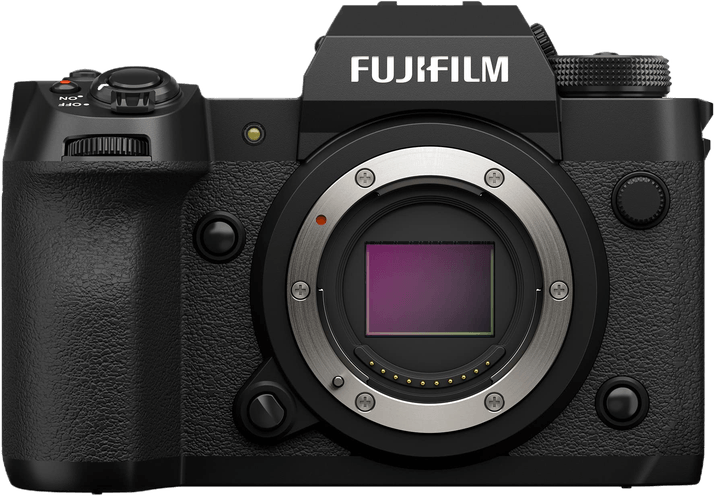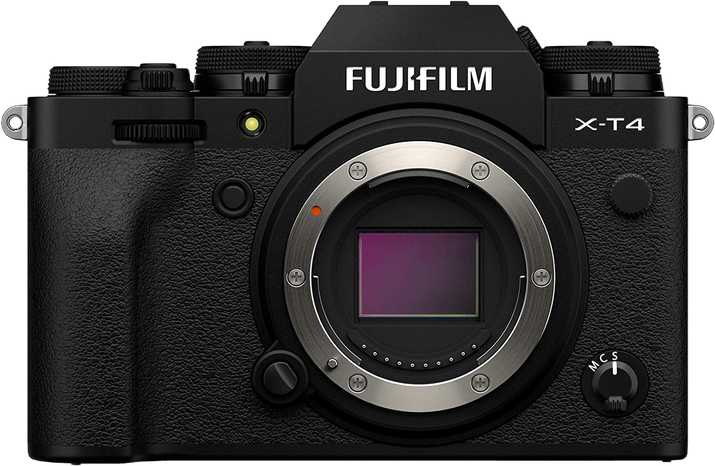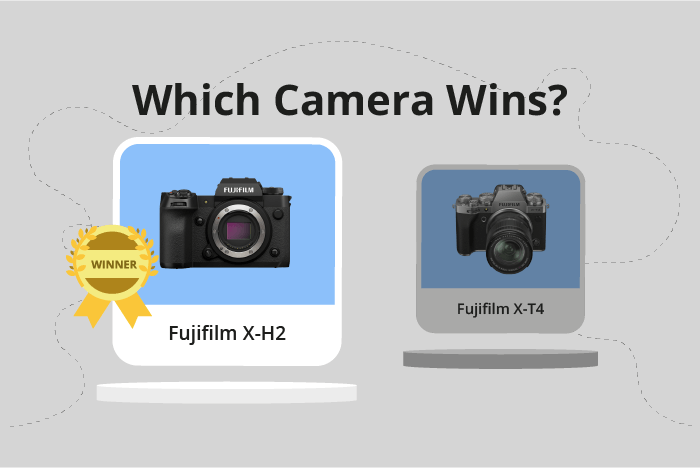Fujifilm X-H2 vs X-T4 Comparison
Fujifilm X-H2

Fujifilm X-T4

The Fujifilm X-H2 takes the lead with a score of 82/100, while the Fujifilm X-T4 trails behind at 76/100. Both cameras are mirrorless and share similar dimensions, with the X-H2 being slightly larger at 136 x 93 x 95mm compared to the X-T4’s 135 x 93 x 84mm.
The X-H2’s higher score reflects its superior performance and features. It was announced more recently on 05/31/2022 and has a launch price of $1999. However, the X-T4, released in 2020, is more affordable at $1699, making it a more budget-friendly option for some users.
In terms of weight, the X-T4 is lighter at 607g or 1.34lbs, while the X-H2 weighs 660g or 1.46lbs. This makes the X-T4 easier to carry around for extended periods of time.
Despite the differences in score, weight, and price, both cameras offer great value in their respective categories. The Fujifilm X-H2 is an excellent choice for those seeking the latest technology and features, while the Fujifilm X-T4 is a more budget-friendly and lighter alternative that still delivers solid performance.
Fujifilm X-H2 vs X-T4 Overview and Optics
The Fujifilm X-H2 emerges as the winner in the optics comparison with a score of 81/100, while the Fujifilm X-T4 trails behind at 73/100. Both cameras share several specifications, such as the CMOS sensor type, APS-C sensor size, Fujifilm X lens mount, and image stabilization. Additionally, neither camera has a DXOMARK score, as DXOMARK does not score Fujifilm cameras.
The X-H2 outperforms the X-T4 in terms of megapixels, boasting 40 megapixels compared to the X-T4’s 26. This higher megapixel count allows the X-H2 to capture more detail in images, making it a superior choice for photographers who prioritize image quality. Furthermore, the X-H2 features the more advanced X-Processor 5, which improves image processing capabilities and enhances overall performance.
On the other hand, the X-T4 holds an advantage in shooting speed, offering 20 frames per second (fps) compared to the X-H2’s 15 fps. This faster shooting speed benefits photographers who capture fast-moving subjects or engage in action photography.
Taking these points into consideration, the Fujifilm X-H2 stands out as the better option for those who prioritize image quality and processing power. The advanced processor and higher megapixel count contribute to its higher optics score. However, the Fujifilm X-T4 remains a viable choice for photographers who require a faster shooting speed for capturing action-packed moments. Ultimately, the choice between these two cameras depends on the specific needs and priorities of the photographer.
Fujifilm X-H2 vs X-T4 Video Performance
The Fujifilm X-T4 outperforms the Fujifilm X-H2 in video capabilities, with a video score of 91/100 compared to the X-H2’s 83/100. Both cameras share some common specifications, including 4K max video resolution and built-in time-lapse functionality.
The X-T4 is superior due to its higher max video dimensions of 4096 x 2160, compared to the X-H2’s 3840 x 2160. This difference allows the X-T4 to capture more detailed and higher quality video content. Additionally, the X-T4 offers a higher max video frame rate of 120fps, doubling the X-H2’s 60fps. This higher frame rate enables the X-T4 to record smoother slow-motion footage and provides greater flexibility in post-production.
While the Fujifilm X-H2 may not surpass the X-T4 in video specifications, it still offers respectable video performance with its 4K max video resolution and built-in time-lapse functionality. The X-H2 is a capable camera for users who prioritize other features, such as photography, over video capabilities.
When comparing the video capabilities of these two cameras, the Fujifilm X-T4 is the clear winner due to its higher video score, greater max video dimensions, and superior max video frame rate. The X-H2, while not as strong in video performance, remains a viable option for users with different priorities. Ultimately, the choice between these two cameras will depend on individual preferences and requirements.
Fujifilm X-H2 vs X-T4 Features and Benefits
The Fujifilm X-H2 and Fujifilm X-T4 both score 85 points in features, making them equally impressive in this aspect. They share several key specifications, including a 3-inch screen size, 1620000-dot screen resolution, touchscreen capability, flip screen, GPS absence, WIFI, and Bluetooth connectivity.
The X-H2 excels in certain areas compared to the X-T4. However, since both cameras have identical feature scores and specifications, it is challenging to identify specific advantages of the X-H2 over the X-T4. Thus, the X-H2 and X-T4 stand on equal ground in terms of features.
On the other hand, the X-T4 may have some advantages over the X-H2. Yet, since both cameras have the same feature scores and specifications, it is also difficult to pinpoint specific areas where the X-T4 outperforms the X-H2. Consequently, the X-T4 and X-H2 remain equally competitive in terms of features.
Based on the provided information, the Fujifilm X-H2 and Fujifilm X-T4 are equally matched in features, with no clear winner. Both cameras offer a solid set of specifications, making them suitable choices for various photography and videography needs. Potential buyers should consider other factors, such as price, design, and personal preferences, when deciding between these two cameras.
Fujifilm X-H2 vs X-T4 Storage and Battery
The Fujifilm X-H2 outperforms the X-T4 in storage and battery, scoring 79 out of 100, while the X-T4 scores 73. Both cameras have two memory card slots and are UHS-II compatible. They also use the same NP-W235 battery type and offer USB charging.
The X-H2’s advantage lies in its 680-shot battery life, significantly longer than the X-T4’s 500 shots. Additionally, the X-H2 accepts CFexpress Type B cards, providing faster read and write speeds compared to the SD/SDHC/SDXC cards used by the X-T4.
The X-T4, however, does not have any advantages in storage and battery over the X-H2. Its lower score stems from its shorter battery life and slower memory card compatibility.
Considering these factors, the Fujifilm X-H2 is the superior choice for photographers seeking longer battery life and faster memory card performance, while the X-T4 may still be suitable for those with less demanding storage and battery requirements.
Alternatives to the Fujifilm X-H2 and X-T4
Are you still undecided about which camera is right for you? Have a look at these popular comparisons that feature the Fujifilm X-H2 or the Fujifilm X-T4:

